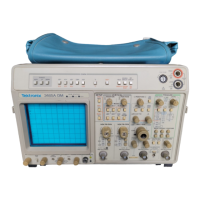Operation
Measure Frequency
with
Cursors
1.
Turn
on
the
1/~t
cursors
and
readout
by
pressing the
~V
and
~t
buttons together.
2.
Align the cursors with identical
pOints,
such
as
zero crossings,
on
adjacent cycles of the waveform, using the
~
REF
and
~
knobs.
3.
The readout shows the frequency of the signal.
4.
Press
~
V
and
~t
together or press either
~
button twice to turn off the
1 /
~
t cursors
and
readout.
Measure Voltage Ratio, Time Ratio (such as Duty Factor), or
Phase
1.
Set VOL TS/DIV or SEC/DIV
so
a feature of the waveform which you
consider the 100% reference covers more than five divisions of the
graticule.
2.
Turn the VOL TS/DIV
VAR
or SEC/DIV VAR counterclockwise from the
detent
until the 100% reference feature covers exactly five divisions.
You
can
use
one signal
as
a reference
and
compare others to it. For
phase, set one
cycle, which
is
the 360 degree reference, to five
divisions.
3.
Press
~
V to measure
vOltage
ratio, At for time ratio, or
~
V
and
At
together for phase. The VAR must
be
counterclockwise from the detent
position to turn
on
the RATIO or PHASE readout.
4.
Turn
~
REF
and
~
to align the cursors with the portion of the waveform
to
be
compared to the reference portion. Phase
is
usually a two-channel
measurement between zero crossings. (Se sure zero crossings for
phase measurements
are
positioned at the graticule center.)
5.
The readout shows the ratio or phase shift.
6.
Press the same
AV
or
~t
button, or both, to turn off the cursors
and
readout.
Choosing Tracking or Independent Delta Mode
Use
the INDEP mode for most measurements, with
each
cursor
independently adjustable. Use TRACK mode, where the A
REF
knob moves
both cursors
as
a pair, to compare waveform features. The A control moves
only the
~
cursor.
2465A/2455A/2445A Operators
2-11

